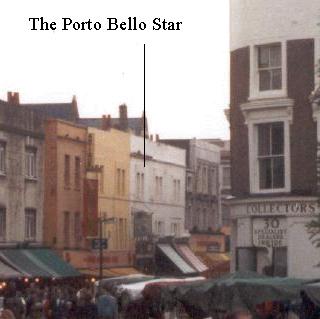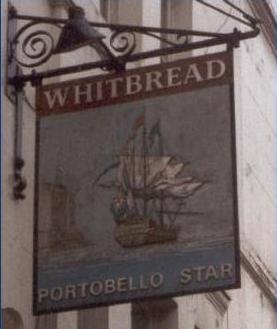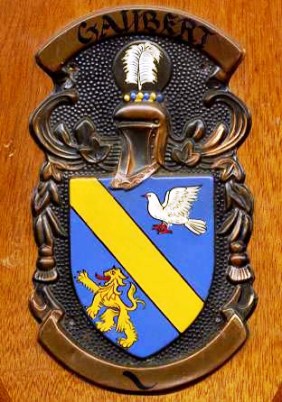In the City of Westminster
Archives I found the volume of St Martins Fleet Marriages. These
marriages were unusual in that they were conducted in the Fleet Prison,
not the church because of the circumstances eg the bride being pregnant
or the parents refusing permission and it was quick, easy and cheap. See below for more information on Fleet marriage taverns.
There is a record on 9th
May 1751 for David Gaubert, bachelor, occupation: dyer, marrying Sarah
Jenings (note:single 'n'), spinster. David's name is also shown as Gobart and Gaubart.
This couple must be the same David & Sarah, parents
of Edward Stephen and Elizabeth, as shown at in the will
of Stephen Gaubert made in 1774 and proven in 1782 (see http://www.gaubertgenealogy.freeola.org/Wills.html.)
"David Gaubert born before 1720 married Sarah and they had Edward Stephen chr 02.02.1752 at St Martins in the Fields and Elizabeth chr 03.08.1755" So whatever this couple's reasons were, Sarah gave birth around the time of her wedding. The Archive also sadly records Sarah on 31st July 1780 in St Martins Examinations (ref RG7 240 page 168 F5066).
 |
This Examination on her oath saith that she is 57 years of age that she is the Wife of David Gaubert gone from her these 10 years to whom she was Married at the Fleet about twenty-nine years ago, that her said husband was a Dyer by Trade and Lived and rented an apartment of Eleven Pounds by the year next Door to the Sign of the Porto Bello in Saint Martins Lane in the said Parish of Saint Martin in the Fields for the space of Three years quitted the same between Nine and Ten years ago. |  |
I've
viewed the original and have made this reproduction.
'The Examination of Sarah Gaubert by an
Order of Removal of two of His Majesty's Justices of the Peace from the
Parish of Saint James within the Liberty of Westminster in the County
of Middlesex to the Parish of Saint Martins in the Fields in the
Liberty and County aforesaid taken this 31st Day
of July 1780.
That her said Husband hath not kept House and rent…of
ten Pounds by the year paid any Parish taxes nor been a yearly hired
servant in any one place for Twelve Months together…
to this Examinant's knowledge nor
…this Examinant since
Sworn this 31st Day
of The……Mark
of
July 1780 before X
The tragic lives of David and Sarah in the workhouse are given in more detail at http://www.gaubertgenealogy.freeola.org/LondonLives.html
William Hyde
"Monamy, the famous Marine-painter,
decorated a carriage for the gallant and unfortunate Admiral Byng, with
ships and naval trophies; and he also painted a portrait of Admiral
Vernon's ship for a famous public - house of the day, well known by the
sign of the 'Porto Bello', remaining until recently, within a few doors
north of the church in St Martin 's-lane".
"... there was a turnpike in
St.Martin's-lane, leading to Covent Garden .
No.20, is a Public-house called 'The Portobello,' with the date 1638 on the front. I remember it had Admiral Vernon's ship, extremely well painted by Monamy, for its sign. This Public-house, with many other miserable dwellings, has given way for the public improvements which are now in progress." (Nollekens and His Times, by J.T.Smith, 1828, Vol II, p.236; Recollections of Public Characters sometime Inhabitants of St.Martin's Lane)
Huguenot Marriages at the Fleet Prison
(extracted from settlement examination at St Martin-in-the-Fields)
For the years 1725-75 there are over 30,000 settlement examinations at St Martin's in the Fields, Westminster. These concerned people applying for poor relief, or thought likely to need to apply, were examined as to their parish of birth (which would be liable to pay for them and to which they might be sent) and whether they had done anything subsequently to make them the responsibility of a different parish.
The most usual ways to obtain a new settlement were serving an apprenticeship, paying rates for a year or working for a year. Women however automatically acquired their husband's place of settlement by marriage so that married women were naturally asked to say when and where they were married.
The majority of marriages naturally took place in an Anglican parish church but in the first half of the 1700s an increasing proportion of Londoners, and many people from the Home Counties generally, travelled to the Fleet Prison (or, technically, the Liberty of the Fleet, a non parochial area on the western side of the City).
There they could obtain quick, easy and cheap marriage by Anglican ministers who had set up marriage shops. Most of the ministers will have been in prison for debt. Over 800 notebooks of 'Fleet marriages' survive (though there is a great deal of duplication between day books and fair copies).
The original are in the National Archives and have been microfilmed. However very few of the registers have been transcribed and this material remains very intractable. The volunteers indexing St Martin's -in- the Fields settlement examinations have abstracted and indexed separately all the references they found to people who claimed to have married in the Fleet. The following are those who look as though they may have been Huguenot descendants. In the following list the maiden name of the woman does not appear since this was irrelevant to the examination. However a few women had had first husbands and the surnames of these are noted.
The first year is that of marriage (sometimes calculated from information which may be inaccurate (such as that of the Duliers who said they had been married 11 years the previous July 12). The F reference is to the volume of settlement examinations in Westminster Local Studies Library.
The second year is that of the examination followed by the page number within the volume.
In many cases the woman will have been examined and referred to her husband, who may indeed have been dead or absent. Some couples were examined more than once some years apart.
None of the marriages in the Fleet Prison can have taken place after March 1754 when Lord Hardwicke's Marriage Act made public marriage in a parish church after banns or with licence the only legal form.
| Gobart | Tobias and Mary | 1727 | F 5034 | 1741 | p151 |
| Gaubert/Gawbert | Edward & Sarah Brown | 16th Feb. 1741/2 | |||
| Gaubart | David and Sarah | 1751 | F 5066 | 1780 | p276 |
| Gobart | David and Sarah | 1751 | F 5057 | 1768 | p168 |
The Fountain Tavern which was on the Strand, at around number 101-104. Lillywhite’s London Signs puts The Fountain at No.421, near the Savoy and near Fountain Court. Lillywhite’s London Coffee Houses (1963) suggests that this was half tavern, half coffee house, used also by the Society of Antiquaries as a meeting venue in 1709. It lists it as burning out in 1742, before which it stood on Numbers 103 and 104 (or possibly 101 and 102) The Strand, on Horwood’s 1799 Map.
FLEET MARRIAGE TAVERNS from: 'The Fleet Prison', Old and New London: Volume 2 (1878), pp. 404-416. URL: http://www.british-history.ac.uk/report.aspx?compid=45111 Date accessed: 28 August 2013.
This Parish begins by the Naked Boy near Strand Bridge, and runneth to the Savoy on the South side, and on the North side of the Strand, from Wimbleton House to the Corner of Katharine Street. And so up that side of Katharine Street to the Fountain Tavern: where it crosses the Street into little Katharine Street, taking in the South side, with that Part of Eagle Court towards White Hart Yard: and so down the South side thereof unto Drury Lane. And against Wich Street it crosseth and takes in the South side thereof unto the Five Bell Inn; and from thence crosseth into the Strand by the Cheesemongers, and from thence all the North side of the Strand to Katharine Street Corner; as appears by the Mapp.
That Part of the Strand, which is in this Parish, is the best Part of it, both for the Largeness of the Street and the Goodness of the Buildings, and Ability of the Inhabitants, who drive a considerable Trade, being so near the Court.
Then in the High Street in the Strand, there was a fair Bridge, called Strand Bridge, and under it a Lane, or way to the Water side, which said Lane is yet remaining; but nought remains of the Bridge, but that the Place yet retains the Name.
from: 'The Fleet Prison', Old and New London: Volume 2 (1878), pp. 404-416. URL: http://www.british-history.ac.uk/report.aspx?compid=45111 Date accessed: 28 August 2013
In the seventeenth and early part of the eighteenth centuries couples desiring to be secretly married came to the Fleet and King's Bench prisons, where degraded clergymen could easily be found among the herd of debtors to perform the ceremony.
The Fleet Chapel was used for debtors' marriages till 1686, when the incumbent of St. James's, Duke's Place, Aldgate, being suspended by the Commissioners for Ecclesiastical Causes, made it too popular as a place for secret marriages; and the chapel becoming the haunt of dangerous lookers-on, the degraded clergymen of the prison and neighbourhood began to celebrate secret marriages in rooms of adjoining taverns, or in private houses adjacent to Fleet Street, Ludgate Hill, and the Mint, keeping registers, to give an appearance of legality, and employing touts, to attract and bring in victims.
Mr. J. C. Jefferson, in his valuable work, "Brides and Bridals," has taken great pains with this subject of Fleet parsons, and has ransacked all possible books, old or new, for information about them.
"Scanty particulars," he says, "have been preserved of about forty persons who were keepers of marrying-houses. Some of these persons were turnkeys, or subordinate officials, in the Fleet Prison, like Bartholomew Bassett, who was clerk of the Fleet Chapel, and tenant, at the exorbitant rent of£100, of the Fleet cellars, where marriages were solemnised secretly. It was at Bassett's office, or private chapel, that Beau Fielding married his first wife, before he fixed his affections on the Duchess of Cleveland. A few of the forty negotiators in wedlock were women, who had come into possession of a register and marrying business by inheritance. Most of them, however, had in the first instance been simple innkeepers, supplying the public with adulterated liquors before they entered the matrimonial trade.
"Standing in the chief thoroughfares or side-alleys and by-yards of the Fleet quarter, their taverns had signs, some of which still pertain to hostelries of the locality. For instance: 'The Cock,' near Fleet Bridge, and 'The Rainbow' Coffee House, at the corner of Fleet Ditch, were famous marrying houses, with signs honourably known at the present day to frequenters of Fleet Street taverns. The 'Cock and Acorn,' the 'Fighting Cocks,' the 'Shepherd and Goat,' the 'Golden Lion,' the 'Bishop Blaze,' the 'Two Lawyers,' the 'Wheatsheaf,' the 'Horseshoe and Magpie,' the 'King's Head,' the 'Lamb,' the 'Swan,' the 'Hoop and Bunch of Grapes,' were some of the taverns in or near Fleet Street and Fleet Market, provided with chaplains and chapels, or private rooms, in which marriages were solemnised on every day and night of the year.
.
